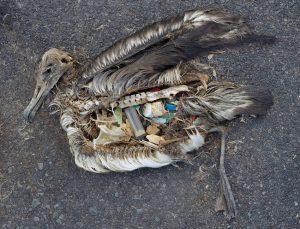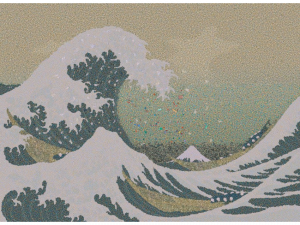Chris Jordan – The Big Picture
Tyler Sanford
Preface
My name is Tyler Sanford. This portfolio is titled: ‘The Big Picture’ and traverses the relationship between man and environment. The license I will be using is CC BY 4.0.
Introduction
Chris Jordan is an environmental photographer and artist who exposes shocking amounts of American mass consumption with his strikingly emotional, large-format, long-zoom artwork displayed worldwide. He illustrates the massive quantities of waste and debris accumulated by modern United States culture by meticulously arranging thousands of photographs into commonly identifiable designs from afar and a jolting, harsh reality up close. With twelve projects published publicly and more in progress, Jordan’s goal is to by “employing themes such as the near versus the far, and the one versus the many” he aims “to raise some questions about the roles and responsibilities we each play as individuals in a collective that is increasingly enormous, incomprehensible, and overwhelming.”



Themes
- The first theme present in Jordan’s art is the overwhelmingly antagonistic impact humans have on the environment, especially on the fauna of the Earth. Humans impact the environment negatively in many ways, and the largest problem being pollution.
- The second theme at hand in Jordan’s artwork is the publicity and recognition of humankind’s ignorance in their role within the destruction of the Earth through shocking and enlightening statistics shared by his art.
Analysis
Chris Jordan uses his platform of artistic expression to express the painstaking truth that mankind is slowly, but surely, destroying the integrity of our planet Earth. With his large-format, long-zoom artwork and photography Jordan embeds major global issues that need to be addressed to the forefront. The fascinating use of global statistics inspires Jordan to address these issues in an abstract manner in order to enlighten his audience as to the true detrimental impact we as humans are causing, without remorse, but doing next to nothing to change.
Jordan’s drive behind his artwork came from his awareness of worldwide mass consumption; living in Seattle it was “the obvious subject right in front of my face”. Over time, Jordan branched his artistic expression from photography to other formats such as three dimensional art and drawings in order to address other global concerns. He wanted to bring these major, easily dismissed issues to the forefront in order to help clear the ignorance of man in its own role within these major issues, and help create a more conscious society. The statistics he used allowed the audience to get a better grasp of the importance of these issues, and allowed for a better understanding. For example, within Jordan’s project “Midway: Message from the Gyre” began in 2009, he photographed decayed albatrosses with loads of plastics, detritus, and harmful pollutants visible within their stomachs within the Midway Atoll, a remote cluster of islands more than two thousand miles from the nearest continent. Mother albatrosses feed their chicks lethal quantities of floating trash for food as they forage over the vast, polluted Pacific Ocean because of the grandiose amount of debris left floating atop the surface of the water. His purpose behind this project was to bring forth the downfall of American consumerism for the wildlife in which we so poorly live alongside. Jordan exclaims, “Our detriment as first-world humans is that we find ourselves lacking the ability to discern anymore what is nourishing from what is toxic to our lives and our spirits.” Jordan’s piece, “Gyre” (2009) depicts the ocean and a large wave containing visible detritus falling from the apex of the crashing wave. This image was created by using 2.4 million pieces of plastic, equal to the estimated number of pounds of plastic pollution that enter the world’s oceans every single hour. Another enlightening statistic is present in Jordan’s work “Silent Spring” (2014); he left the aquatic realm and redirected the focus towards our beloved United States. Within this graphite drawing by Jordan and Clark 183,000 birds are depicted; the reason behind this number is to share the sickening statistic that 183,000 birds die evert day within the U.S. from exposure to agricultural pesticides. The use of background statistics – specifically in reference to the death toll of avian wildlife and the sheer amount of plastic within the ocean – increase the magnitude of Jordan’s art, and the story it is sharing with the audience. Jordan continues to work on new artistic projects in hopes to raise awareness of these major global concerns that certainly will not fix themselves.
Application
Chris Jordan is an environmental photographer, artist, and self-proclaimed activist. The art he creates brings attention to major global concerns, but his most popular being mass consumption. His intricate artwork often uses a long-zoom style in order to visually increase the severity of the concept being portrayed. In many works, Jordan utilizes numbers and statistics to be incorporated within the art so that each piece can tell a story that leaves a long-term impact on the audience. Often, Jordan’s art causes the audience to speculate their own role, and the country’s role as a whole, in the pollution of the world around us. Within his TED Talk given in February of 2008, Jordan states that “we will inherit the result of our decisions”. By this he simply means that if we continue heading in the direction of mass production and consumption and we do not make a change to reduce the carbon footprint left around our Earth, or clean up the dirty footprints we continue to make each and every day, we will be our own downfall; it is just a matter of time.
Media Attributions
- “Midway: Message from the Gyre”, (2009 – Current) by Chris Jordan is licensed by CC BY-NC-ND 4.0.
- “Gyre”, 2009 by Chris Jordan is licensed by CC BY-NC-ND 4.0.
- “Silent Spring”, 2014 by Chris Jordan and Rebecca Clark is licensed by CC BY-NC-ND 4.0.
Media Attributions
- Midway
- Gyre
- Silent Spring

